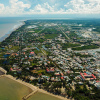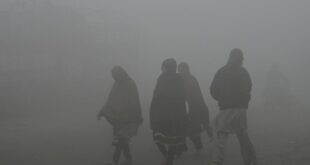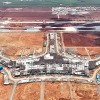Ho Chi Minh City authorities are struggling to transform the metropolis’s industrial system of labor-intensive factories that put pressure on infrastructure without bringing in big revenues.
 |
|
Workers of Taiwanese shoemaker Pou Yuen leave their factory in Ho Chi Minh City’s Binh Tan District in October 2021. Photo by VnExpress/Thanh Nguyen |
At 4:30 p.m. every day, as many as 50,000 workers leave Taiwanese shoemaker Pou Yuen’s Ho Chi Minh City factory in Binh Tan District. The city’s largest employer makes Adidas, Nike and Reebok shoes.
As soon as the workday ends, heavy traffic congestion surrounds the factory.
At the factory’s main gate, more than 300 buses idle in line to send around 13,500 workers back home to localities in other provinces such as Tien Giang, Tay Ninh, Long An and Ben Tre.
The clamor that takes over the neighborhood takes more than an hour to subside.
Population boom
Pou Yuen, which opened 27 years ago, and other businesses in the Tan Tao Industrial Park have caused the population of Binh Tan to increase at an average of 20% per year recently.
As home to more than 800,000 people, Binh Tan is the second most populous district in the city, just behind Thu Duc City, which was established in January 2021 by combining districts 2, 9 and Thu Duc.
The district’s population has grown at a rate 1.5 times higher than authorities had planned in recent years.
Its population is expected to reach 1.2 million people by 2040 and 1.6 million by 2060, according to district deputy chairman Vu Chi Kien.
What to do
Kien says that industrial zones have brought many economic benefits to the district over the past 20 years, but they have also created environmental, social and transportation problems.
“We need to move labor-intensive industrial parks out of existing residential areas to serve urban development,” he added.
In agreement with Kien, official city plans to develop industrial and export processing zones have called for labor-intensive factories to be moved away from the center of Binh Tan.
The district has also asked the municipal People’s Committee to help transform existing industrial zones into “creative urban areas” where high-tech production exists alongside combinations of trade, services and culture.
“Many land lease contracts at industrial parks will expire in about 20 years, so now the district needs to proactively determine how we will transform instead of waiting until the contracts expire to make a plan,” said Kien.
Money
Despite the pressure caused on city infrastructure, industries that use a lot of workers in HCMC have not generated high revenues for the city.
HCMC industrial land rents are only US$6.23 million per hectare compared to US$8.7 million per hectare in Dong Nai Province, according to the Ho Chi Minh City Export Processing and Industrial Zones Authority (Hepza).
At the same time, labor-intensive sectors have failed to attract as much investment as sectors that use fewer laborers.
 |
|
Workers at the Dony garment factory in HCMC’s Tan Binh District, October 2021. Photo by VnExpress/Quynh Tran |
Hepza data shows that the textile and garment sector accounts for the highest proportion of labor in the city, at nearly 41%, but only contributes 11.3% of investment capital.
The amount of investment capital flowing into the labor-light sectors of electronics, telecommunications and informatics is 1.3 higher than the garment industry, while total number of employees is only one third as large.
The chemicals, rubber and plastics manufacturing sectors also have a higher proportion of capital and lower proportion of laborers compared to textiles and garments.
Changes
The city aims to gradually reduce the amount of labor-intensive industries that use outdated technologies, cause environmental pollution, and consume too many natural resources. Such projects will not be allowed to extend their operations or expand production scales if the businesses refuse to convert technologies and use fewer laborers.
According to an approved master plan, HCMC will have 23 export processing and industrial zones with a total area of nearly 6,000 hectares by 2030.
To date, only 17 out of 19 established zones have been put into operation, which means an occupancy rate of 77%.
Hepza said the city will give priority to attracting investment projects using advanced technologies and less laborers into zones that have been planned but have yet to be occupied.
Nguyen Thi Bich Ngoc, deputy head of Hepza’s Investment Management Department, said that Hepza will improve the quality of capital attraction by developing a set of industrial park investment criteria this year.
Experts expect that Hepza will ask the city to help the four industrial parks of Tan Thuan, Tan Binh, Cat Lai and Hiep Phuoc in districts 7, Tan Binh, Hiep Phuoc and Thu Duc City apply new technologies and use less laborers starting next year.
- Reduce Hair Loss with PURA D’OR Gold Label Shampoo
- Castor Oil Has Made a “Huge” Difference With Hair and Brow Growth
- Excessive hair loss in men: Signs of illness that cannot be subjective
- Dịch Vụ SEO Website ở Los Angeles, CA: đưa trang web doanh nghiệp bạn lên top Google
- Nails Salon Sierra Madre
 VnExpress News The News Gateway of Vietnam
VnExpress News The News Gateway of Vietnam





